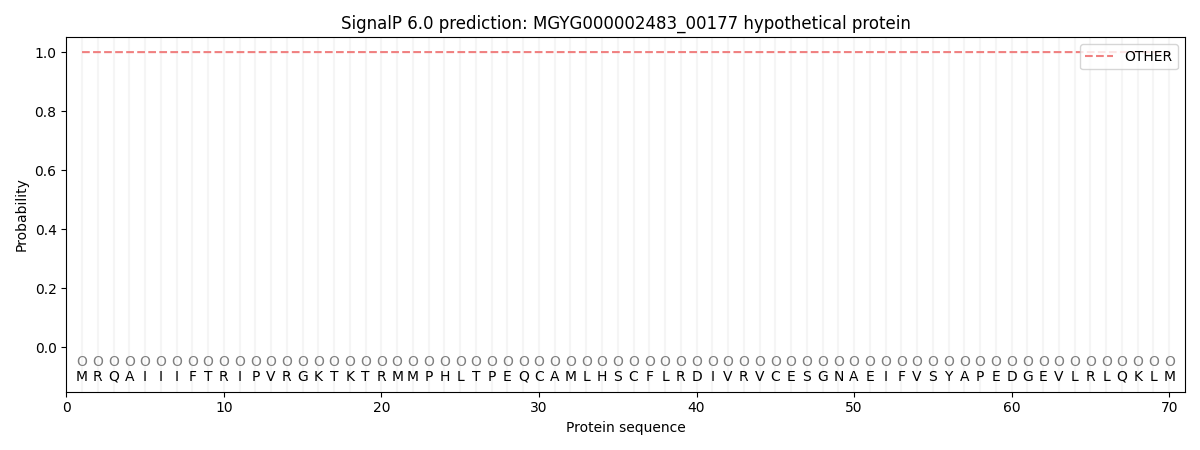You are browsing environment: HUMAN GUT
CAZyme Information: MGYG000002483_00177
You are here: Home > Sequence: MGYG000002483_00177
Basic Information |
Genomic context |
Full Sequence |
Enzyme annotations |
CAZy signature domains |
CDD domains |
CAZyme hits |
PDB hits |
Swiss-Prot hits |
SignalP and Lipop annotations |
TMHMM annotations
Basic Information help
| Species | Clostridium_Q saccharolyticum_A | |||||||||||
|---|---|---|---|---|---|---|---|---|---|---|---|---|
| Lineage | Bacteria; Firmicutes_A; Clostridia; Lachnospirales; Lachnospiraceae; Clostridium_Q; Clostridium_Q saccharolyticum_A | |||||||||||
| CAZyme ID | MGYG000002483_00177 | |||||||||||
| CAZy Family | GT2 | |||||||||||
| CAZyme Description | hypothetical protein | |||||||||||
| CAZyme Property |
|
|||||||||||
| Genome Property |
|
|||||||||||
| Gene Location | Start: 159783; End: 161117 Strand: - | |||||||||||
CAZyme Signature Domains help
| Family | Start | End | Evalue | family coverage |
|---|---|---|---|---|
| GT2 | 222 | 339 | 7e-17 | 0.7470588235294118 |
CDD Domains download full data without filtering help
| Cdd ID | Domain | E-Value | qStart | qEnd | sStart | sEnd | Domain Description |
|---|---|---|---|---|---|---|---|
| TIGR04283 | glyco_like_mftF | 6.71e-92 | 221 | 440 | 1 | 220 | transferase 2, rSAM/selenodomain-associated. This enzyme may transfer a nucleotide, or it sugar moiety, as part of a biosynthetic pathway. Other proposed members of the pathway include another transferase (TIGR04282), a phosphoesterase, and a radical SAM enzyme (TIGR04167) whose C-terminal domain (pfam12345) frequently contains a selenocysteine. [Unknown function, Enzymes of unknown specificity] |
| TIGR04282 | glyco_like_cofC | 4.41e-76 | 5 | 193 | 1 | 189 | transferase 1, rSAM/selenodomain-associated. Members of this protein family show strongly correlated phylogenetic distribution, and in most cases co-clustering, with an unusual radical SAM enzyme (TIGR04167) whose C-terminal pfam12345 domain often contains a selenocysteine residue. Other members of the conserved gene neighborhood include another putative glycosyltransferase, an alkylhydroperoxidase family protein (TIGR04169), and a phosphoesterase family protein (TIGR04168). The cassette is likely to be biosynthetic but its exact function is unknown. [Unknown function, Enzymes of unknown specificity] |
| cd02522 | GT_2_like_a | 4.75e-63 | 221 | 440 | 1 | 221 | GT_2_like_a represents a glycosyltransferase family-2 subfamily with unknown function. Glycosyltransferase family 2 (GT-2) subfamily of unknown function. GT-2 includes diverse families of glycosyltransferases with a common GT-A type structural fold, which has two tightly associated beta/alpha/beta domains that tend to form a continuous central sheet of at least eight beta-strands. These are enzymes that catalyze the transfer of sugar moieties from activated donor molecules to specific acceptor molecules, forming glycosidic bonds. Glycosyltransferases have been classified into more than 90 distinct sequence based families. |
| pfam09837 | DUF2064 | 1.55e-28 | 48 | 153 | 8 | 113 | Uncharacterized protein conserved in bacteria (DUF2064). This family has structural similarity to proteins in the nucleotide-diphospho-sugar transferases superfamily. The similarity suggests that it is an enzyme with a sugar substrate. |
| COG3222 | COG3222 | 5.95e-25 | 3 | 193 | 5 | 197 | Uncharacterized conserved protein, glycosyltransferase A (GT-A) superfamily, DUF2064 family [Function unknown]. |
CAZyme Hits help
| Hit ID | E-Value | Query Start | Query End | Hit Start | Hit End |
|---|---|---|---|---|---|
| CBK78105.1 | 0.0 | 1 | 444 | 1 | 444 |
| SET56509.1 | 1.30e-215 | 1 | 444 | 1 | 445 |
| ADL03784.1 | 6.70e-211 | 1 | 444 | 1 | 445 |
| QRV21896.1 | 6.70e-211 | 1 | 444 | 1 | 445 |
| QRP38681.1 | 9.70e-208 | 1 | 444 | 1 | 443 |
PDB Hits download full data without filtering help
| Hit ID | E-Value | Query Start | Query End | Hit Start | Hit End | Description |
|---|---|---|---|---|---|---|
| 3CGX_A | 4.45e-22 | 5 | 193 | 7 | 198 | ChainA, Putative nucleotide-diphospho-sugar transferase [Oleidesulfovibrio alaskensis G20] |
Swiss-Prot Hits help
SignalP and Lipop Annotations help
This protein is predicted as OTHER

| Other | SP_Sec_SPI | LIPO_Sec_SPII | TAT_Tat_SPI | TATLIP_Sec_SPII | PILIN_Sec_SPIII |
|---|---|---|---|---|---|
| 1.000031 | 0.000001 | 0.000000 | 0.000000 | 0.000000 | 0.000000 |
